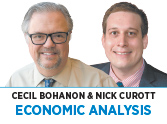Subscriber Benefit
As a subscriber you can listen to articles at work, in the car, or while you work out. Subscribe Now Economics is the study of how scarce resources are allocated among competing uses. As most resources are allocated through a market process in our economy, prices are at the center of economic analysis.
Economics is the study of how scarce resources are allocated among competing uses. As most resources are allocated through a market process in our economy, prices are at the center of economic analysis.
The price mechanism is an amazingly effective way for resources to be directed to their best valued uses. Yet there are times when a society might choose to use non-market, non-price methods of resource allocation. This is occurring with the COVID vaccination.
Governments have fast-tracked the rules for vaccine development and contracted to buy the vaccine in bulk at agreed-upon (but not necessarily transparent) prices. After governments take delivery of the vaccines, they will provide them to citizens at zero user charge. We don’t have a quarrel with this policy, but simply note that it leaves unsolved the basic economic problem: If prices don’t allocate resources, what does?
The mechanism appears to be a hodgepodge of international, national, state and local directives. In general, they have two themes. First, the higher level of government allocates the vaccine to the various sub-units based on those sub-units’ populations. Second, the order of who gets vaccinated seems clear: “front-line” health care workers first, then the most vulnerable age/health groups, then essential workers.
Sensible, but as always, the devil is in the details. Here are two that occur to us.
If Indiana County X does not have the capacity to distribute all its vaccine, should County Y that has the capacity to inoculate more people get part of X’s allocation? It seems silly to let vaccine languor in X when it could be used in Y. Note how the market process for, say, tins of corned beef works this out. Prices differences and the profit motive ensure that market actors have both the information and incentives to ship from a market with excess supply to one with excess demand. There is no clear mechanism that does this for the COVID vaccine.
Second, who is most vulnerable? Does an 88-year-old at a nursing home take precedence over a hospital receptionist? Does a healthy 85-year-old take precedence over a 62-year-old with diabetes? These problems will have to be hashed out.
With more than 3,000 county health departments on the front lines, conflicts are bound to emerge; mistakes will be made. So, no, we are not suggesting allocating vaccines to the highest bidder. Just pointing out that resource-allocation problems don’t magically disappear with non-price allocation.•
__________
Bohanon and Curott are professors of economics at Ball State University. Send comments to ibjedit@ibj.com.
Please enable JavaScript to view this content.
